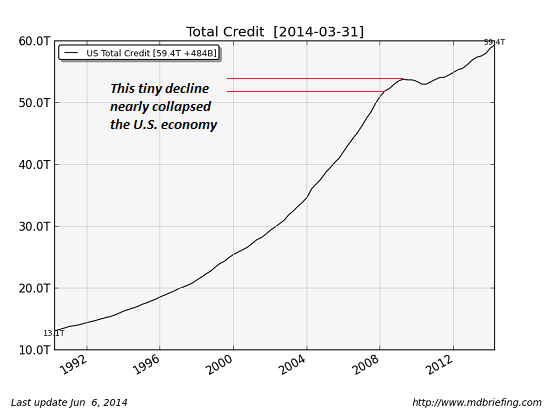Even if the economy were growing at a faster pace, it wouldn't come close to offsetting the interest payments on our ever-expanding debt.
If you want to know why the Status Quo is unsustainable, just look at interest and debt. These are not difficult to understand: debt is a loan that must be paid back or discharged/written off and the loss absorbed by the lender. Interest is paid on the debt to compensate the owner of the money for the risk of loaning it to a borrower.
It's easy to see what's happening with debt and the real economy (as measured by GDP, gross domestic product): debt is skyrocketing while real growth is stagnant. Put another way--we have to create a ton of debt to get a pound of growth.
There is no other way to interpret this chart.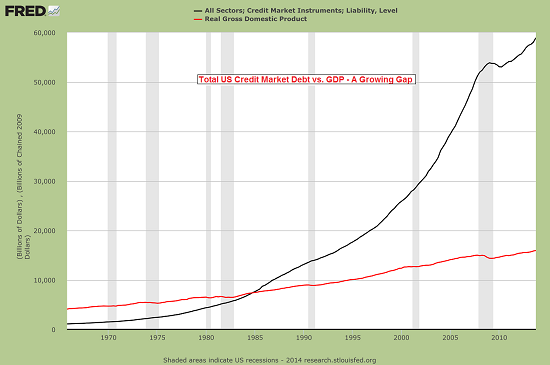
The Status Quo has only survived this crushing expansion of debt by dropping interest rates to historic lows. This is a chart of the yield on the 10-year Treasury bond, which reflects the extraordinary decline in interest rates over the past two decades.
The Federal Reserve has pegged rates at essentially 0% for years. That means the strategy of lowering interest rates to enable more debt has run out of oxygen: rates can't drop any lower, and so they can either stay at current levels or rise.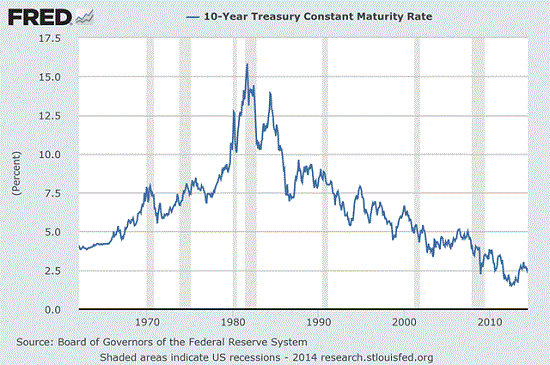
Near-zero interest rates for banks borrowing from the Fed doesn't mean conventional borrowers get near-zero rates: auto loans are around 4%, credit cards are still typically 16% to 25%, garden-variety student loans are around 8% and conventional mortgages are about 4.25% to 4.5% for 30-year fixed-rate home loans.
This decline in interest rates means households can borrow more money while paying the same amount in interest.
So the interest payment on a $30,000 car today is actually less than the payment on a $15,000 auto loan back in 2000.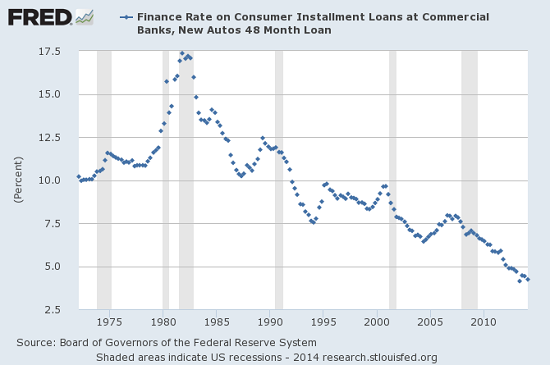
The monthly payment on a $400,000 home mortgage is roughly the same as the payment at much higher rates on a $200,000 home loan 15 years ago.
So dropping the interest rates has enabled a broad-based expansion of debt across the entire economy. Notice how debt has exploded higher in every segment of the economy: household, finance, government, business.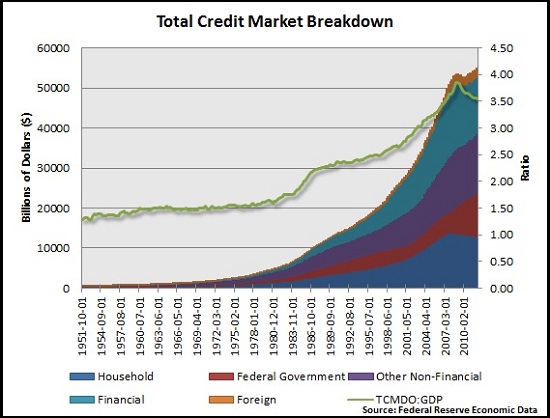
The other half of the debt/interest rate equation is household income: if income is stagnant and declining, the household cannot afford to take on more debt and pay more interest. With real (adjusted for inflation) household income declining for all but the top 10%, households cannot take on more debt unless rates drop significantly.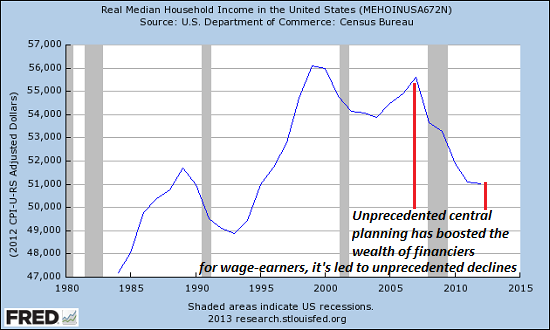
Now that rates are at historic lows, there is no more room to lower rates further to enable more debt. That gambit has run its course.
Many financial pundits claim private debts can simply be transferred to the government and the problem goes away. Unfortunately, they're dead-wrong. As economist Michael Pettis explains, bad debt cannot simply be “socialized”:
Remember that the only way debt can be resolved is by assigning the losses, either during the period in which the losses occurred or during the subsequent amortization period. There is no other way to “resolve” bad debt – the loss must be assigned, today or tomorrow, to some sector of the economy. “Socializing” the debt, or transferring the debt from one entity to another, does not change this.
There are three sectors to whom the cost can be assigned: households, businesses, or the government.
Earlier losses are still unrecognized and hidden in the country’s various balance sheets. These losses will either be explicitly recognized or they will be implicitly amortized. The only interesting question, as I see it, is which sector will effectively be assigned the losses. This is a political question above all....
In other words, when marginal borrowers--households, students, businesses, local government agencies, etc.--start defaulting, the losses will have to be taken by somebody. This is true of every indebted nation: Japan, the European nations, China and the U.S.
The idea that we can transfer the debt to the government or central bank and the losses magically vanish is simply wrong.
Even if you drop interest rates, if debt keeps soaring the interest soon becomes crushing. Even at historically low rates, the interest on Federal debt will soon double. That means some other spending must be cut or taxes must be increased to pay the higher interest costs. Either action reduces spending and thus growth.
If rates actually normalize, i.e. rise back toward historic norms, interest payments could triple.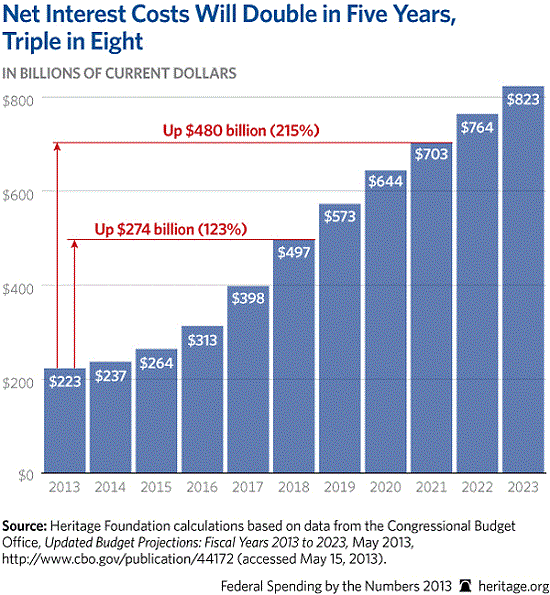
source: Federal Spending by the Numbers, 2013: Government Spending Trends in Graphics, Tables, and Key Points
Here's one way to understand how reliance on ever-expanding debt hollows out the economy. Let's say the average interest on the $60 trillion in total debt is 4%. (Recall that charge-offs for defaulted loans must be included as debt-related expenses. The interest paid to lenders is only one expense in the debt system; the other is the losses taken by lenders for defaulted credit card loans, mortgages, etc.)
That comes to $2.4 trillion annually.
Now take the $16 trillion U.S. economy and reckon that real growth in gross domestic product (GDP), even with questionable hedonic adjustments and understated inflation, is about 1.5% annually. That's an increase of $240 billion annually.
That means we're eating over $2 trillion every year of our real wealth, i.e. our seed corn, to support an ever-increasing mountain of debt. That is not sustainable. Even if the economy were growing at a faster pace, it wouldn't come close to offsetting the interest payments on our ever-expanding debt.
This leaves the entire Status Quo increasingly vulnerable to any sort of credit shock; either rising rates or a decline in the rate of debt expansion will cause the system to implode.